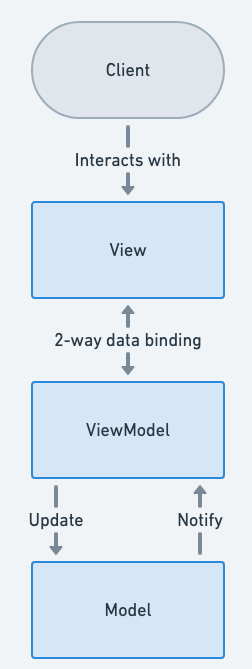Model-View-ViewModel Pattern in Java: Separating UI and Logic for Cleaner Code
Also known as
- MVVM
Intent of Model-View-ViewModel Design Pattern
The intent of the Model-View-ViewModel (MVVM) pattern in Java is to provide a clear separation of concerns between the UI logic, the presentation logic, and the business logic by dividing the application into three interconnected components: Model, View, and ViewModel.
Detailed Explanation of Model-View-ViewModel Pattern with Real-World Examples
Real-world example
Consider a real-world analogous example of the MVVM pattern similar to organizing a cooking show. In this scenario:
Model: Represents the recipe itself, which includes the ingredients and the steps needed to cook the dish. The model is purely about the data and rules for preparing the dish but does not concern itself with how this information is presented to the audience.
View: Is akin to the kitchen set where the cooking show is filmed, including all the visual elements like the layout of the kitchen, the placement of ingredients, and the cookware. The view is responsible for the visual presentation and how the audience sees the cooking process.
ViewModel: Acts like the script for the cooking show, where it interprets the recipe (model) and organizes the flow of the show. It tells the chef (view) what to display next, when to add ingredients, and how to respond to changes like substituting an ingredient. The ViewModel bridges the gap between the technical details of the recipe and the chef's presentation, ensuring the audience understands each step without delving into the complexities of the recipe itself.
In this example, the ViewModel allows the chef to focus on cooking and interacting with the audience, while the underlying recipe remains unchanged, promoting a clear separation of concerns.
In plain words
The MVVM design pattern separates an application into three distinct components: the Model, which holds the data and business logic; the View, which displays the user interface; and the ViewModel, which acts as an intermediary to bind data from the Model to the View.
Wikipedia says
Model–view–viewmodel (MVVM) is a software architectural pattern that facilitates the separation of the development of the graphical user interface (the view) – be it via a markup language or GUI code – from the development of the business logic or back-end logic (the model) so that the view is not dependent on any specific model platform.
Architecture diagram

Programmatic Example of Model-View-ViewModel Pattern in Java
ViewModel will hold the business logic and expose the data from model to View.
public class BookViewModel {
@WireVariable
private List<Book> bookList;
private Book selectedBook;
private BookService bookService = new BookServiceImpl();
public Book getSelectedBook() {
return selectedBook;
}
@NotifyChange("selectedBook")
public void setSelectedBook(Book selectedBook) {
this.selectedBook = selectedBook;
}
public List<Book> getBookList() {
return bookService.load();
}
/** Deleting a book.
*/
@Command
@NotifyChange({"selectedBook","bookList"})
public void deleteBook() {
if (selectedBook != null) {
getBookList().remove(selectedBook);
selectedBook = null;
}
}View will have no logic, only UI elements.
<zk>
<window title="List of Books" border="normal" width="600px" apply="org.zkoss.bind.BindComposer" viewModel="@id('vm') @init('com.iluwatar.model.view.viewmodel.BookViewModel')">
<vbox hflex="true">
<listbox model="@bind(vm.bookList)" selectedItem="@bind(vm.selectedBook)" height="400px" mold="paging">
<listhead>
<listheader label="Book Name"/>
<listheader label="Author"/>
</listhead>
<template name="model" var="book">
<listitem >
<listcell label="@bind(book.name)"/>
<listcell label="@bind(book.author)"/>
</listitem>
</template>
</listbox>
</vbox>
<toolbar>
<button label="Delete" onClick="@command('deleteBook')" disabled="@load(empty vm.selectedBook)" />
</toolbar>
<hbox style="margin-top:20px" visible="@bind(not empty vm.selectedBook)">
<vbox>
<hlayout>
Book Name : <label value="@bind(vm.selectedBook.name)" style="font-weight:bold"/>
</hlayout>
<hlayout>
Book Author : <label value="@bind(vm.selectedBook.author)" style="font-weight:bold"/>
</hlayout>
<hlayout>
Book Description : <label value="@bind(vm.selectedBook.description)" style="font-weight:bold"/>
</hlayout>
</vbox>
</hbox>
</window>
</zk>To deploy the example, go to model-view-viewmodel folder and run:
mvn clean installmvn jetty:run -Djetty.http.port=9911- Open browser to address: http://localhost:9911/model-view-viewmodel/
When to Use the Model-View-ViewModel Pattern in Java
MVVM is applicable in applications requiring a clear separation between the user interface and the underlying business logic, especially in large-scale, data-driven applications where UI and business logic change independently. This makes the Model-View-ViewModel pattern ideal for Java applications.
Model-View-ViewModel Pattern Java Tutorials
- Data Binding in Android (developer.android.com)
- Introduction to Model View View Model (MVVM) (GeeksforGeeks)
- Patterns - WPF Apps With The Model-View-ViewModel Design Pattern (Microsoft)
Real-World Applications of Model-View-ViewModel Pattern in Java
- Widely used in JavaFX applications for desktop interfaces.
- Utilized in Android development with libraries like DataBinding and LiveData for reactive UI updates.
- ZK Framework zkoss.org
- KnockoutJS knockoutjs.com
Benefits and Trade-offs of Model-View-ViewModel Pattern
Benefits:
- Improved testability due to decoupling of business and presentation logic.
- Easier maintenance and modification of the user interface without affecting the underlying data model.
- Enhanced reusability of the ViewModel across different views if designed generically.
Trade-offs:
- Increased complexity in small applications where simpler patterns might suffice.
- Learning curve associated with understanding and applying the pattern correctly.
Related Java Design Patterns
- MVC (Model-View-Controller): MVVM can be seen as a derivative of MVC with a stronger emphasis on binding and decoupling, where the ViewModel acts as an intermediary unlike the controller in MVC.
- MVP (Model-View-Presenter): Similar to MVVM but with a focus on the presenter handling the UI logic, making MVVM's ViewModel more passive in terms of direct UI manipulation.